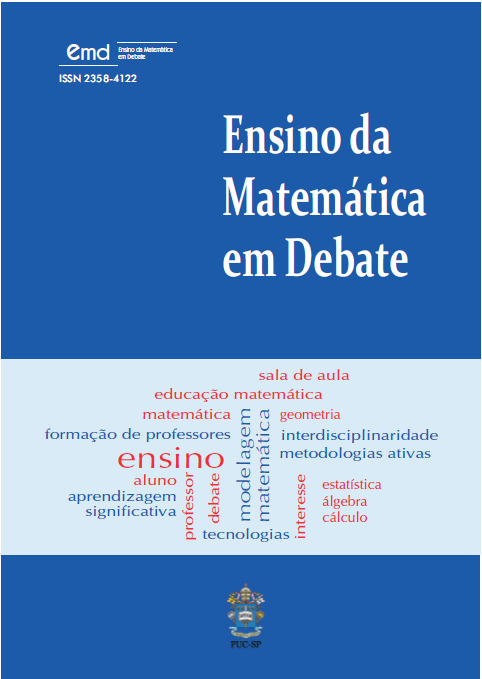The GeoGebra Software and the Learning of Spatial Geometry: a systematic literature review
Keywords:
Augmented Reality, GeoGebra, Learning, Space GeometryAbstract
With the insertion of technologies in education, software is developed to promote interaction between people and support the teaching and learning processes. In this context, this article aims to map studies on the use of Augmented Reality (AR) technology through the GeoGebra software for teaching Spatial Geometry. In the methodological part, this took place in three stages based on Kitchenham (2004), namely: the first stage (planning), aimed at building the “search string” using keywords related to the topic studied; the second stage (conduction), testing the “search string” in the selected databases: Google Scholar, CAPES Periodicals, SciELO, Science Direct and Scribd, from 2015 to 2023 and producing the report or final report of the study . After applying the inclusion criteria and exclusion criteria, 43 studies were selected in the final filtering stage. Of these, the use of the GeoGebra software in teaching and learning Spatial Geometry in Basic Education was observed, but mostly in the computer version, that is, working with 2D visualization, although work developed using AR through of GeoGebra from 2021, thus proving an expansion of AR, corroborating Cardoso (2014). Therefore, although the existence of other software in Geometry teaching has been observed, GeoGebra, obtained free of charge on its official website, through AR technology contributes to the development of visualization skills, which are important for the formation of geometric concepts.
References
ALMEIDA, M. E. B. Tecnologia na escola: criação de redes de conhecimentos. In:
ALMEIDA, M. E. B. MORAN.J. M. (org). Integração das tecnologias na educação. Secretaria de Educação a Distância. Brasília. Ministério da Educação: SEED, 2005. Disponível em: http://www.dominiopublico.gov.br/download/texto/me000701.pdf. Acesso em 25 nov. 2022.
AUSUBEL, David. P. Aquisição e Retenção de Conhecimentos: Uma Perspectiva Cognitiva. Lisboa: Plátano, 2003.
AZUMA, R. et al. “Recent advance in augmented reality”. Em IEEE Computer Graphics and Applications, 21 (6), 2001.
BASNIAK, M. I; ESTEVAM, Everton José Goldoni. O GeoGebra e a Matemática da educação básica: frações, estatística, círculo e circunferência. Curitiba: Ithala, 2014.
BUCIOLI, A. A. B.; LAMOUNIER, Edigard Afonso Júnior. Visualização de ambientes virtuais com simulação de projeção holográfica. In: Workshop de Realidade Virtual e Aumentada, 2014, Marília, SP. ANAIS DO WRVA'14, 2014. Disponível em: http://www.lbd.dcc.ufmg.br/colecoes/wrva/2014/025.pdf. Acesso em 02 nov. 2022.
BRASIL. Secretaria de Educação Fundamental. Parâmetros Curriculares Nacionais: Matemática / Secretaria de Educação Fundamental. Brasília: MEC /SEF, 1997.
BRASIL. Lei de Diretrizes e Bases da Educação Nacional (LDBEN), Lei n° 9394/96. Brasília, DF, 1996.
BRASIL. Base Nacional Comum Curricular (BNCC). Educação é a Base. Brasília, MEC/CONSED/UNDIME, 2017. Disponível em: http://basenacionalcomum.mec.gov.br/images/BNCC_EI_EF_110518_versaofinal_site.pdf. Acesso em 25 out. 2022.
CARDOSO, R.G.S. et al. Uso da realidade aumentada em auxílio à educação. In: Computador na Praia. 2014. Florianópolis, SC. UNIVALI. 2014. pág. 330-339. 2014. Disponível em: http://www6.univali.br/seer/index.php/acotb/article/viewFile/5337/2794. Acesso em 28 out. 2022.
CONTENT, R. R.. O que é Java? Conheça as Particularidades dessa Linguagem de Programação, 2019. Disponível em: https://rockcontent.com/br/blog/o-que-e-java/. Acesso em: 03 de ago. de 2020.
DEMO, P. Educação hoje: "novas" tecnologias, pressões e oportunidades. São Paulo: Atlas, 2009.
KITCHENHAM, B. Procedures for performing systematic reviews. Keele, UK, Keele University, v. 33, n. 2004, p. 1-26, 2004.
KITCHENHAM, B.; CHARTERS, S. Guidelines for performing systematic literature
reviews in software engineering. EBSE Technical Report, 2007.
MORAN, José Manuel, MASETTO, Marcos & BEHRENS, Marilda. Novas tecnologias e mediação pedagógica. 12a ed. São Paulo: Papirus, 2006.
PONTE, J. P.; BROCARDO, J.; OLIVEIRA, H. Investigações matemáticas na sala
de aula. 1. ed. Belo Horizonte: Autêntica, 2006.
VALENTE, J. A. A Comunicação e a Educação baseada no uso das Tecnologias Digitais de Informação e Comunicação. Revista Unifeso, n. 1, Campinas, SP. 2014.
Downloads
Published
How to Cite
Issue
Section
License
Copyright (c) 2023 Ensino da Matemática em Debate

This work is licensed under a Creative Commons Attribution-NonCommercial 4.0 International License.

Este obra está licenciado com uma Licença Creative Commons Atribuição 4.0 Internacional.





